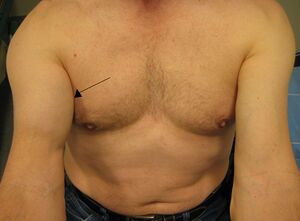Biceps Squeeze Test: Difference between revisions
Anas Mohamed (talk | contribs) No edit summary |
Anas Mohamed (talk | contribs) No edit summary |
||
| Line 3: | Line 3: | ||
[[File:Biceps tendon tear.jpeg|thumb]] | [[File:Biceps tendon tear.jpeg|thumb]] | ||
The Biceps Squeeze Test is a Diagnostic test for distal [[Biceps brachii|biceps]] tendon rupture. | The Biceps Squeeze Test is a Diagnostic test for distal [[Biceps brachii|biceps]] tendon rupture. | ||
Image 1: Right distal bicipital tendon rupture. | |||
* Distal biceps rupture is from the excessive eccentric force as the arm is brought into extension from flexion. These activities include weightlifting, wrestling, and labor-intensive job. Risk factors include age, [[Smoking and Exercise|smoking]], [[obesity]], use of [[Corticosteroid Medication|corticosteroids]], and [[Overuse Injuries - an Individualised Approach|overuse]]. | |||
* The incidence of distal biceps [[Tendon Biomechanics|tendon]] rupture is around 2.55 per 100,000 patient-years. Most patients (more than 95%) are males, and injury events usually happen during middle age (35 years to 54 years). Rupture of the distal biceps mainly involves the dominant limb.<span class="reference" id="cite_ref-:0_1-0"></span> | |||
* Another test that can be used is the [[Elbow Hook Test|hook test]] (used to identify the absence of the biceps tendon at its distal insertion).<ref>Hsu D, Anand P, Chang KV. Biceps tendon rupture. StatPearls [Internet]. 2020 Apr 20.Available: <nowiki>https://www.ncbi.nlm.nih.gov/books/NBK513235/?report=printable</nowiki> (accessed 29.9.2021)</ref> | |||
=== Technique === | === Technique === | ||
Revision as of 19:51, 30 September 2021
Purpose[edit | edit source]
The Biceps Squeeze Test is a Diagnostic test for distal biceps tendon rupture.
Image 1: Right distal bicipital tendon rupture.
- Distal biceps rupture is from the excessive eccentric force as the arm is brought into extension from flexion. These activities include weightlifting, wrestling, and labor-intensive job. Risk factors include age, smoking, obesity, use of corticosteroids, and overuse.
- The incidence of distal biceps tendon rupture is around 2.55 per 100,000 patient-years. Most patients (more than 95%) are males, and injury events usually happen during middle age (35 years to 54 years). Rupture of the distal biceps mainly involves the dominant limb.
- Another test that can be used is the hook test (used to identify the absence of the biceps tendon at its distal insertion).[1]
Technique[edit | edit source]
Step 1. Patient position in sitting with the forearm comfortably supported on the patient's lap.
Step 2. Elbow is flexed approximately 60-80 degrees (at this level of flexion stress on the brachialis minimizes and helps isolate the biceps from forearm supination).
Step 3. The forearm is slightly pronated and the examiner stands on the side of the limb to be examined.
Step 4. The examiner squeezed biceps brachii firmly with both hands, one hand on the myotendinous junction and the other around the muscle belly (when biceps brachii squeezed, deformation of the proximal muscle should create tension in the distal tendon resulting in forearm supination. This would not occur if the distal tendon is avulsed from its insertion on the radius.)[2]
Step 5. A positive test indicates the absence of supination of the forearm during the test shows a rupture of the distal biceps tendon.
Evidence[edit | edit source]
The study was done in 2005 resulting in 23 patients were tested positive out of 24 patients which shows the sensitivity of 96%.[2]
References[edit | edit source]
- ↑ Hsu D, Anand P, Chang KV. Biceps tendon rupture. StatPearls [Internet]. 2020 Apr 20.Available: https://www.ncbi.nlm.nih.gov/books/NBK513235/?report=printable (accessed 29.9.2021)
- ↑ 2.0 2.1 Ruland, CDR Robert T MC, USNR; Dunbar, CDR (Sel) Robert P MC, USNR; Bowen, CDR James D MC, USN The Biceps Squeeze Test for Diagnosis of Distal Biceps Tendon Ruptures, Clinical Orthopaedics and Related Research: August 2005 - Volume 437 - Issue - p 128-131 doi: 10.1097/01.blo.0000167668.18444.f5
- ↑ Carpal Compression Test. The Student Physical Therapist. Available from: https://youtu.be%7C5vC-r1FaZZE
- ↑ Patient Self Diagnose Carpal Tunnel Syndrome - Everything You Need To Know - Dr. Nabil Ebraheim. nabil ebraheim. Available from: https://youtu.be%7CJPC-ltrHTKY







